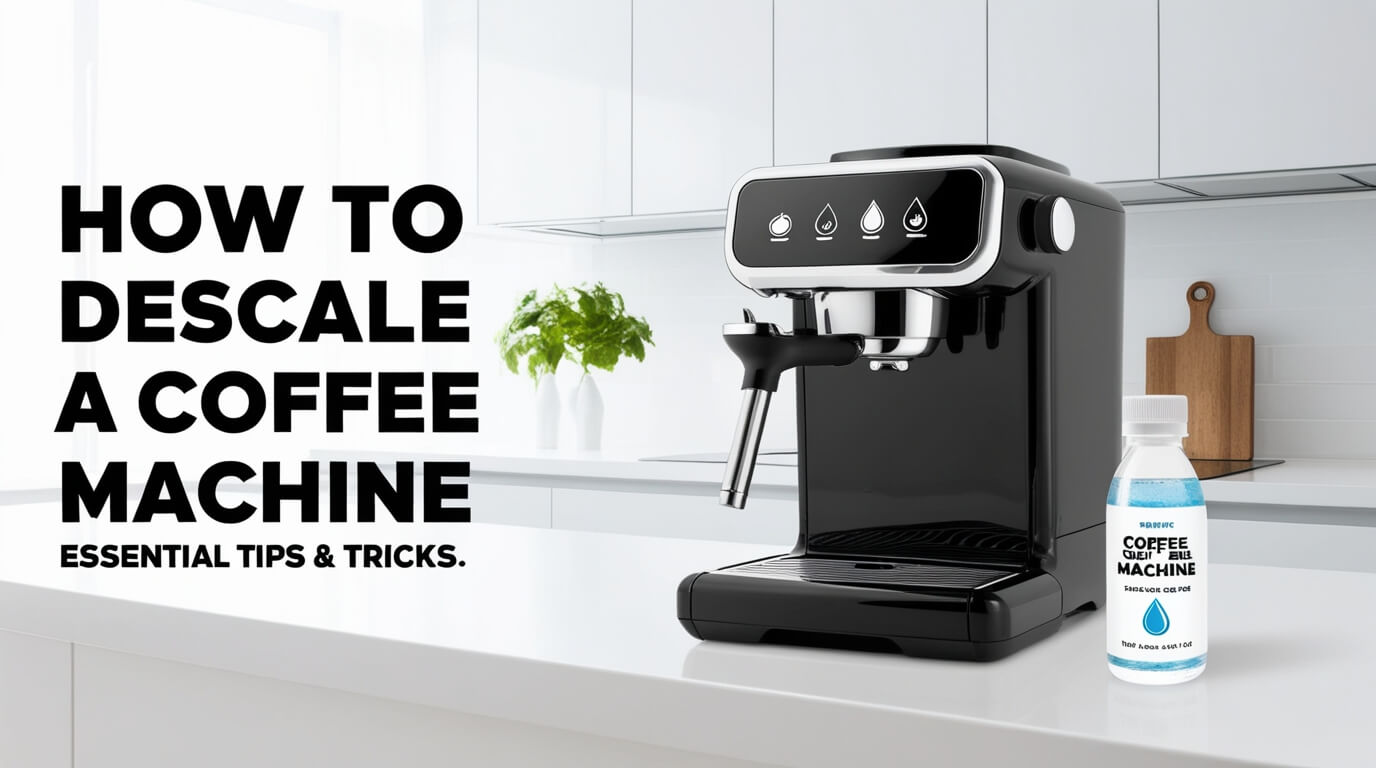
Descaling a coffee machine removes mineral buildup, improves taste, and extends your machine’s lifespan. This guide covers everything from recognizing when to descale to step-by-step instructions for various methods. We’ll explore commercial and natural solutions, troubleshoot common issues, and answer frequently asked questions.
Coffee Machine Descaling
What is descaling?
Descaling is the process of removing mineral deposits that accumulate inside your coffee machine over time. These deposits, often called limescale or calcium buildup, come from the minerals in your water supply.
Why is descaling your coffee machine important?
Descaling keeps your coffee tasting great and your machine running smoothly. Here’s why it matters:
- Better-tasting coffee: Limescale can make your brew taste bitter or off.
- Improved machine performance: Buildup can clog pipes and slow water flow.
- Energy efficiency: A clean machine heats water faster, using less electricity.
- Longer lifespan: Regular descaling prevents damage to internal parts.
Signs your coffee machine needs descaling
Watch for these red flags:
- Slower brewing times
- Unusual noises during brewing
- White, chalky residue inside the machine
- Bitter or strange-tasting coffee
- Weak coffee despite using the same amount of grounds
Don’t ignore these signs. A neglected machine can harbor harmful bacteria and mold.
Preparing to Descale Your Coffee Machine
Gathering necessary supplies
Before you start, make sure you have:
- Descaling solution (commercial or homemade)
- Clean, lint-free cloth
- Fresh water
- Empty carafe or pot
Checking manufacturer’s instructions
Different coffee machines may have specific descaling requirements. Always check your user manual first. Some manufacturers recommend particular descaling products or methods.
Step-by-Step Guide to Descaling Your Coffee Machine
Emptying and cleaning removable parts
- Unplug your machine for safety.
- Remove and empty the water reservoir.
- Take out the filter basket and any reusable filters.
- Wash these parts with warm, soapy water and rinse well.
Preparing the descaling solution
If using a commercial descaler:
- Follow the package instructions for dilution.
- Mix the solution in the water reservoir.
For a homemade solution:
- Mix equal parts white vinegar and water.
- Pour this mixture into the water reservoir.
Running the descaling cycle
- Place an empty carafe or pot on the drip tray.
- Turn on the machine and start a brew cycle.
- Let about half the solution run through, then stop the cycle.
- Leave the remaining solution in the machine for 30-60 minutes.
- Complete the brewing cycle.
Rinsing the machine
- Empty the carafe and rinse it thoroughly.
- Fill the reservoir with fresh water.
- Run two full brew cycles with just water to rinse out any remaining solution.
- Wipe down the exterior of the machine with a damp cloth.
Different Methods for Descaling Coffee Machines
Using commercial descaling solutions
Many brands offer specially formulated descaling products. These are often the safest and most effective option.
Pros:
- Designed specifically for coffee machines
- Usually faster-acting than homemade solutions
- Less likely to leave residual odors or tastes
Cons:
- More expensive than DIY methods
- May contain harsh chemicals
Natural descaling methods with household items
For a more eco-friendly approach, try these natural alternatives:
- Vinegar solution:
- Mix equal parts white vinegar and water
- Effective and affordable, but may leave a slight odor
- Lemon juice solution:
- Mix 1/3 cup lemon juice with 2/3 cup water
- Natural and leaves a fresh scent
- Baking soda method:
- Mix 1/4 cup baking soda with 1 cup warm water
- Great for tough buildup, but requires thorough rinsing
Maintaining Your Coffee Machine After Descaling
Regular cleaning routines
Keep your machine in top shape between descaling sessions:
- Rinse removable parts daily.
- Wipe down the exterior weekly.
- Run a water-only cycle once a week to flush the system.
Preventing mineral buildup
Proactive steps can reduce the frequency of descaling:
- Use filtered water to reduce mineral content.
- Empty and dry the water reservoir when not in use.
- Consider using a water softener if you live in a hard water area.
Troubleshooting Common Descaling Issues
Dealing with stubborn mineral deposits
If regular descaling doesn’t seem to work:
- Try a stronger descaling solution.
- Let the solution sit in the machine longer (up to 2 hours).
- Use a soft brush to gently scrub accessible areas.
What to do if descaling doesn’t improve performance
If your machine still isn’t working well after descaling:
- Check for clogs in the water lines or spray head.
- Inspect the pump and heating element for damage.
- Consider professional servicing if problems persist.
Frequently Asked Questions About Descaling Coffee Machines
How often should I descale my coffee machine?
The frequency depends on your water hardness and machine usage. As a general rule:
- Soft water areas: Every 3-6 months
- Hard water areas: Every 1-3 months
- Heavy use (office or cafe): Monthly
Can I use vinegar to descale my coffee machine?
Yes, vinegar is an effective natural descaler. However, it may leave a lingering odor and isn’t suitable for all machines. Check your manual before using vinegar.
Is descaling necessary for all types of coffee machines?
Most coffee machines benefit from regular descaling, including:
- Drip coffee makers
- Espresso machines
- Single-serve pod machines
- French press (for thorough cleaning)
Some high-end machines have built-in descaling programs or alerts.
Keeping Your Coffee Machine in Top Shape
Regular descaling is key to great-tasting coffee and a long-lasting machine. By following this guide, you’ll ensure your coffee maker stays clean, efficient, and produces delicious brews every time.
Remember, a little maintenance goes a long way. Set a regular schedule for descaling, and your taste buds (and wallet) will thank you. Happy brewing!






